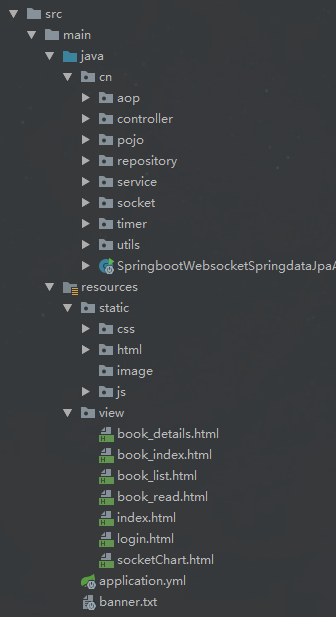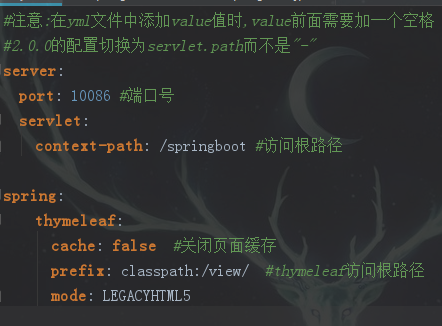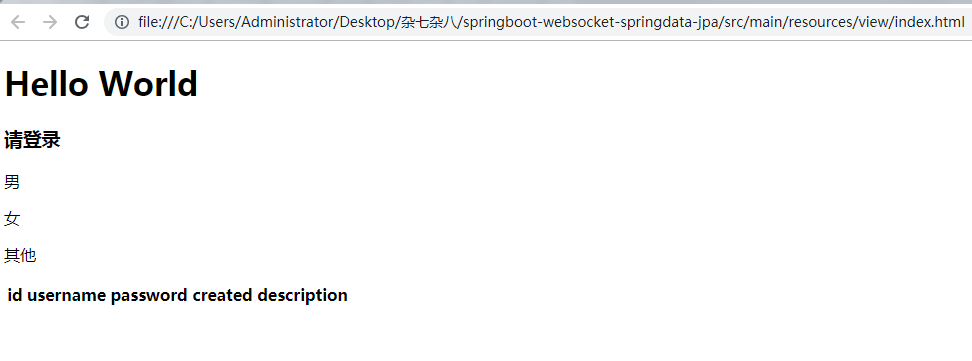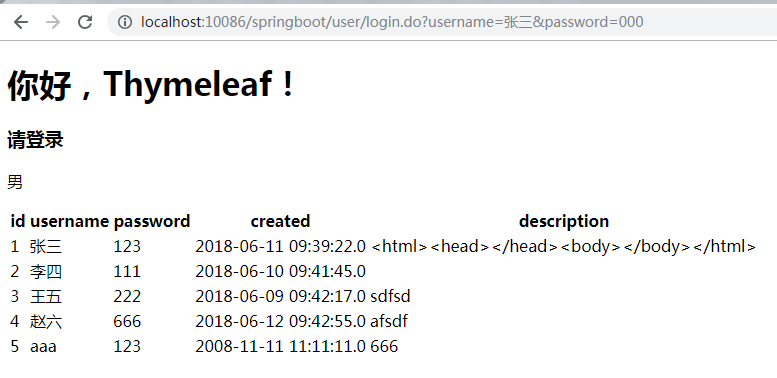前言
thymeleaf是springboot官方推荐使用的java模板引擎,在springboot的参考指南里的第28.1.10 Template Engines中介绍并推荐使用thymeleaf,建议我们应该避免使用jsp,jsp的本质是一个java的servlet类,jsp引擎将jsp的内容编译成.class,"out.write"输出到response再响应到浏览器,虽然java是一次编译,到处运行,但也大大增加了服务器压力,而且jsp将后台java语言嵌入页面,还要放入服务容器才能打开,前后端不分离,严重增加了前端工程师的开发工作、效率。
thymeleaf官网对thymeleaf的介绍:
Thymeleaf is a modern server-side Java template engine for both web and standalone environments.
Thymeleaf's main goal is to bring elegant natural templates to your development workflow — HTML that can be correctly displayed in browsers and also work as static prototypes, allowing for stronger collaboration in development teams.
With modules for Spring Framework, a host of integrations with your favourite tools, and the ability to plug in your own functionality, Thymeleaf is ideal for modern-day HTML5 JVM web development — although there is much more it can do.
thymeleaf使用教程,骚操作:鼠标右键,翻译成简体中文再看。
thymeleaf使用th属性赋予每个标签与后台交互的能力,当html文件在本地直接用浏览器打开,浏览器引擎会忽略掉th属性,并正常渲染页面,当把html文件放到服务容器访问,th属性与后台交互,获取数据替换原先的内容,这样前端工程师在编写html页面时,在本地开发,正常实现页面逻辑效果即可,数据先写死,当放到服务容器时数据从后台获取。
spring对thymeleaf的配置,来自springboot参考手册,Common application properties:https://docs.spring.io/spring-boot/docs/2.1.0.RELEASE/reference/htmlsingle/#common-application-properties
# THYMELEAF (ThymeleafAutoConfiguration) spring.thymeleaf.cache=true # Whether to enable template caching. spring.thymeleaf.check-template=true # Whether to check that the template exists before rendering it. spring.thymeleaf.check-template-location=true # Whether to check that the templates location exists. spring.thymeleaf.enabled=true # Whether to enable Thymeleaf view resolution for Web frameworks. spring.thymeleaf.enable-spring-el-compiler=false # Enable the SpringEL compiler in SpringEL expressions. spring.thymeleaf.encoding=UTF-8 # Template files encoding. spring.thymeleaf.excluded-view-names= # Comma-separated list of view names (patterns allowed) that should be excluded from resolution. spring.thymeleaf.mode=HTML # Template mode to be applied to templates. See also Thymeleaf's TemplateMode enum. spring.thymeleaf.prefix=classpath:/templates/ # Prefix that gets prepended to view names when building a URL. spring.thymeleaf.reactive.chunked-mode-view-names= # Comma-separated list of view names (patterns allowed) that should be the only ones executed in CHUNKED mode when a max chunk size is set. spring.thymeleaf.reactive.full-mode-view-names= # Comma-separated list of view names (patterns allowed) that should be executed in FULL mode even if a max chunk size is set. spring.thymeleaf.reactive.max-chunk-size=0B # Maximum size of data buffers used for writing to the response. spring.thymeleaf.reactive.media-types= # Media types supported by the view technology. spring.thymeleaf.render-hidden-markers-before-checkboxes=false # Whether hidden form inputs acting as markers for checkboxes should be rendered before the checkbox element itself. spring.thymeleaf.servlet.content-type=text/html # Content-Type value written to HTTP responses. spring.thymeleaf.servlet.produce-partial-output-while-processing=true # Whether Thymeleaf should start writing partial output as soon as possible or buffer until template processing is finished. spring.thymeleaf.suffix=.html # Suffix that gets appended to view names when building a URL. spring.thymeleaf.template-resolver-order= # Order of the template resolver in the chain. spring.thymeleaf.view-names= # Comma-separated list of view names (patterns allowed) that can be resolved.
使用
maven引入依赖
<!--Thymeleaf模板依赖-->
<dependency>
<groupId>org.springframework.boot</groupId>
<artifactId>spring-boot-starter-thymeleaf</artifactId>
</dependency>
项目结构
thymeleaf默认,页面跳转默认路径:src/main/resources/templates,静态资源默认路径:src/main/resources/static;

yml配置文件
我们也可以再配置文件中修改它:classpath:/view/

controller页面跳转
使用ModelAndView进行跳转,将数据add进去
@RequestMapping("/login.do")
public ModelAndView login(User user){
Result result=userService.login(user);
ModelAndView mv=new ModelAndView();
mv.addObject("newText","你好,Thymeleaf!");
mv.addObject("gender","1");
mv.addObject("userList",result.getData());
if(result.getData()!=null) {
mv.addObject("loginUser",result.getData());
}
mv.setViewName("index.html");
return mv;
}
html页面取值
引入命名空间,避免校验错误<html xmlns:th="http://www.thymeleaf.org">
<!DOCTYPE html> <!--解决idea thymeleaf 表达式模板报红波浪线--> <!--suppress ALL --> <html xmlns:th="http://www.thymeleaf.org"> <head> <meta charset="UTF-8" /> <title>srpingboot</title> </head> <body> <!-- 属性替换,其他属性同理 --> <h1 th:text="${newText}">Hello World</h1> <!-- 设置多个attr th:attr="id=${user.id},data-xxx=${user.xxx},data-yyy=${user.yyy}" 片段的使用、传值和调用 <div th:fragment="common(text1,text2)"> ... </div> th:insert 是最简单的:它只是插入指定的片段作为其主机标签的主体。 <div th:insert="base ::common(${text1},${text2})"></div> th:replace实际上用指定的片段替换它的主机标签。 <div th:replace="base ::common(${text1},${text2})"></div>
三目表达式:
<h3 th:text="${loginUser != null} ? ${loginUser.username} : '请登录'"></h3>
--> <!-- if-else --> <h3 th:if="${loginUser} ne null" th:text="${loginUser.username}"></h3> <h3 th:unless="${loginUser} ne null">请登录</h3> <!-- switch --> <div th:switch="${gender}"> <p th:case="'1'">男</p> <p th:case="'0'">女</p> <!-- th:case="*" 类似switch中的default --> <p th:case="*">其他</p> </div> <!--
each
其中,iterStat参数为状态变量,常用的属性有
index 迭代下标,从0开始
count 迭代下标,从1开始
size 迭代元素的总量
current 当前元素
--> <table> <thead> <tr> <th>id</th> <th>username</th> <th>password</th> <th>created</th> <th>description</th> </tr> </thead> <tbody> <tr th:each="user,iterStat : ${userList}"> <td th:text="${user.id}"></td> <td th:text="${user.username}"></td> <td th:text="${user.password}"></td> <td th:text="${user.created}"></td> <td th:text="${user.description}"></td> </tr> </tbody> </table> </body> <!-- 引入静态资源 --> <script th:src="@{/js/jquery-1.9.1.min.js}" type="application/javascript"></script> </html>
本地打开

服务容器打开,登录失败页面效果

服务容器打开,登录成功页面效果

标准表达式
简单表达
变量表达式: ${...}
选择变量表达式: *{...}
消息表达式: #{...}
链接网址表达式: @{...}
片段表达式: ~{...}
字面
文本文字:'one text','Another one!',...
号码文字:0,34,3.0,12.3,...
布尔文字:true,false
空字面: null
文字标记:one,sometext,main,...
文字操作:
字符串连接: +
文字替换: |The name is ${name}|
算术运算
二元运算符:+,-,*,/,%
减号(一元运算符): -
布尔运算
二元运算符:and,or
布尔否定(一元运算符): !,not
比较和平等
比较:>,<,>=,<=(gt,lt,ge,le)
等值运算符:==,!=(eq,ne)
条件运算符
if-then: (if) ? (then)
if-then-else: (if) ? (then) : (else)
default: (value) ?: (defaultvalue)
特殊特征符
无操作: _
所有这些功能都可以组合和嵌套,例:
'User is of type ' + (${user.isAdmin()} ? 'Administrator' : (${user.type} ?: 'Unknown'))
官网表达式介绍:https://www.thymeleaf.org/doc/tutorials/3.0/usingthymeleaf.html#standard-expression-syntax
后记
springboot+thymeleaf,前后端分离已经成为了趋势,这里进行学习记录整理,以免以后又要到处查资料。
补充
2019-07-24补充:除此之外,thymeleaf还内置了很多对象,可以从上下文获取数据,还有好多对象的操作方法,具体请看:
附录A:表达式基本对象:https://www.thymeleaf.org/doc/tutorials/3.0/usingthymeleaf.html#appendix-a-expression-basic-objects
附录B:表达式实用程序对象:https://www.thymeleaf.org/doc/tutorials/3.0/usingthymeleaf.html#appendix-b-expression-utility-objects
比如:
在页面获取项目路径
//项目路径 var ctx = [[${#request.getContextPath()}]];
判断集合长度
<p th:if="${#lists.size(list)} < 25"> <p>list集合长度小于25!</p> </p>
字符串全大写、小写
<p th:text="${#strings.toUpperCase(name)}"></p> <p th:text="${#strings.toLowerCase(name)}"></p>
有一点要注意,使用这些内置对象,方法传参里面不需要再用${}来取值了,例如,后台传过来的名称叫name
错误使用:
<p th:text="${#strings.toUpperCase($(name))}"></p>
正确使用:
<p th:text="${#strings.toUpperCase(name)}"></p>
更多内置对象方法请看官网!
补充:本地环境不报错,Linux环境下报错,模板不存在:Error resolving template [/bam/login], template might not exist or might not be accessible by any of the configured Template Resolvers
解决:

把/去掉就可以了

代码开源
代码已经开源、托管到我的GitHub、码云: